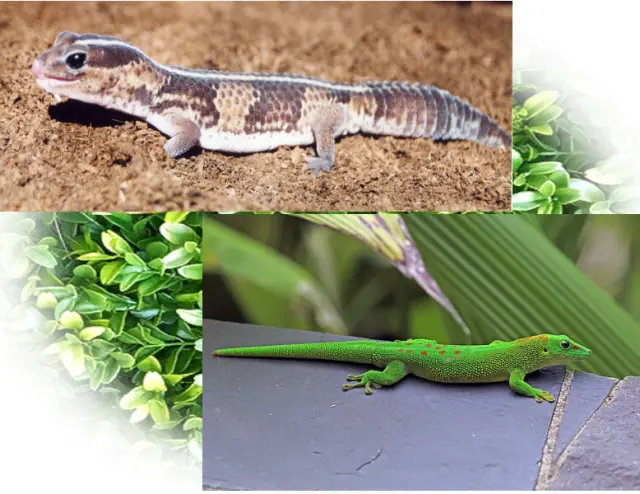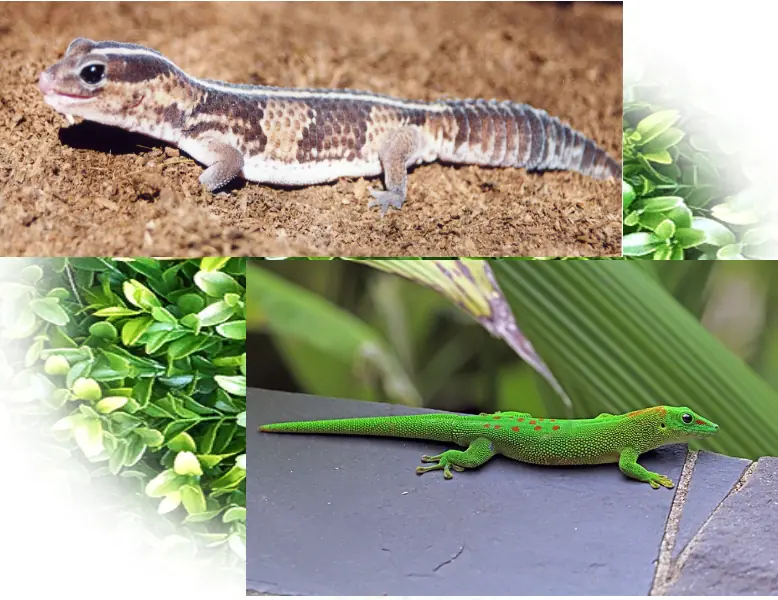African Fat-Tailed Geckos and Giant Day Geckos are excellent pets for first-time owners. They are quite docile and with a little bit of time and patience, you will be able to gain their trust. This means they will accept being handled for a few minutes a day. But you should be aware that they need to be handled very differently so you won’t hurt them.
In this article, we’ll talk about these beautiful creatures and help you decide which one is a better fit for you and your daily schedule.
African Fat Tailed Gecko: The African Fat-Tailed Gecko is the most docile gecko you can possibly own and these creatures are quite beautiful as well. They grow up to 7-9 inches in length and have amazing durability in captivity. Owning one of these geckos comes with a very long-term commitment as they can live up to 25 years. They are also easy to maintain and make the best possible gecko pets for first-time owners and children. These geckos only get aggressive against other African Fat-Tailed male geckos.
Giant Day Gecko: The Giant Day Gecko is easily one of the most adorable-looking geckos in the world. They are green with a few red spots on the back and a few red lines on their face. Owning one means a lot of responsibility as they live up to 15 years in captivity, sometimes even more. You will need a little bit of space as well since they typically grow up to 10 inches in length, including their tail. They are as lovely as they are adorable and they can make great pets as long as you don’t handle them too much.
African Fat Tailed Gecko vs Giant Day Gecko – Which One Is The Better Pet?

A Giant Day Gecko is a lot more active and it likes to stay busy roaming around the enclosure or basking until it’s time for a snack. They also absolutely love when you’re re-arranging the decorations and they get to discover the enclosure all over again. You can do this every time you need to deep-clean the vivarium, which is once or twice a year. It can be more often, depending on your setup. This pet is great for people that want an animal they can observe but not necessarily handle.
Temperament and Habits Comparison
African Fat-Tailed Geckos are nocturnal lizards and will spend most of their time hidden away in humid and dark spaces. When they get hungry, they go out at night looking for insects. Other than that, they don’t move around too much and they absolutely love to nap. The only chance there is for an African Fat-Tailed Gecko to bite you is if you’re hurting it while handling. They’re very docile and they’re quickly getting more and more popular all over the world.
Giant Day Geckos are not aggressive but they will keep their distance from you for a pretty long time until they get used to you, especially if you don’t have time to interact with it too much. These beautiful creatures are also known for their territorial behavior as they will protect their cage against any intruder. The key to a happy Giant Day Gecko is to have lots of climbing space and hiding spots.
The most important thing you need to keep in mind about the Giant Day Gecko is that they should never be picked up. They have a self-defense mechanism that causes their skin to fall when you pick it up. This allows the gecko to get rid of any predator a lot faster. After the skin falls and remains on your hands, leave the gecko alone to heal but supervise it closely. If anything happens, take it to the vet.
Can African Fat Tailed Geckos and Giant Day Geckos live together?
Both the African Fat-Tailed Gecko and the Giant Day Gecko are very territorial creatures. This means they will try and protect their territory from any intruder. Housing them together will only lead to disaster as most geckos don’t stop until one of them is dead. And if the vivarium is not big enough for the other gecko to run and hide, it probably won’t survive the fight. Some geckos stop once one of them loses their tail and runs, and others will even eat the other gecko.
These geckos should only be kept with other geckos from the same species. More than that, you should never house two males together as they will fight just as badly as well. A male should either live alone, with another female, or with multiple females. This works great for both species but never mixed up. There can be fights between females as well. You should pay close attention to the geckos while they are getting used to one another. If they don’t get along, all you can do is separate them.
Diet Comparison
African Fat-Tailed Geckos are strictly insectivores and they only eat live insects. Almost any gecko will stay away from dead insects as it’s similar to you getting a spoiled meal. Crickets, mealworms, roaches, silkworms, waxworms, and more are excellent for them. You should always make sure the prey is never bigger in width than the space between the gecko’s eyes. Otherwise, the gecko risks choking while eating a simple cricket. Their insects also need to be dusted with ReptiCalcium and ReptiVite most of the time.
Giant Day Geckos can eat vegetables, fruits, and live insects. The main part of their diet should always be live insects (never dead), but they also need small pieces of fruit and veggies. They even love baby food and fruit mix, which is excellent as a treat. Only feed the gecko tropical fruits (mango, banana, etc), various veggies, and crickets, brown cockroaches, worms, etc.
Comparison – Cage Requirements (size, substrate, heat level, humidity)
African Fat-Tailed Gecko doesn’t need a lot of space but it’s still better to ensure it has all the room to roam it wants. Any gecko can get destructive if it feels like it’s trapped. A single gecko can live in a 10-gallon tank, a pair will need a 15-gallon tank, and groups are better kept in tanks that are at least 25-gallons. And as a substrate, you can use the popular orchid bark that can be found anywhere. Be careful of using sand as substrate as it can hurt the gecko if it accidentally eats sand.
The Cage of an African Fat-Tailed Gecko needs to have a cool and a hot side. The cool side should be kept just below 80F and the hot side should always remain between 90F to 95F. And the thing that might surprise you a bit is that they need a quite high humidity level. This is because despite living in the desert, they spend their time in humid and dark places. So make sure the humidity is always between 40% and 60%.
Giant Day Geckos love their space so get a 30-gallon tank for 3 or 4 geckos, a 20-gallon tank for a pair, and a single gecko can live OK in a 10-gallon tank. As substrate, moss and orchid bark are great. And don’t forget to invest in an automatic heating and misting system. This will ensure that the cage will keep its humidity between 55% and 65%, and the temperature between 80F to 88F. You should also invest in a good basking spot that can be always kept at 90F.





